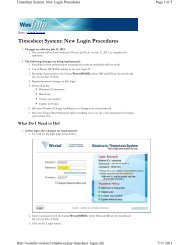The Addiction Behaviors Checklist: Validation of a New ... - Westat
The Addiction Behaviors Checklist: Validation of a New ... - Westat
The Addiction Behaviors Checklist: Validation of a New ... - Westat
Create successful ePaper yourself
Turn your PDF publications into a flip-book with our unique Google optimized e-Paper software.
Vol. 32 No. 4 October 2006 <strong>Addiction</strong> <strong>Behaviors</strong> <strong>Checklist</strong>345is using medications appropriately?’’) assessingeither appropriate or inappropriate opioidmedication use over the past month. It shouldbe noted that the rating clinicians were familiarwith both the patients (for the most partpatients were routinely seen by only one ortwo clinicians over the course <strong>of</strong> the study)and with current concepts <strong>of</strong> addiction, pseudoaddiction,physical dependence, and tolerance.Participants were assessed on a monthlybasis using the global clinical judgment.Opioid Medication Discontinuation for Noncompliance.An additional outcome measure wasthe occurrence <strong>of</strong> major medication contractviolations leading to opioid discontinuationover the course <strong>of</strong> the one-year study. Discontinuationdecisions were made as a group bythe multidisciplinary pain clinic treatmentteam based on results <strong>of</strong> urine toxicologyscreens, medication contract violations, andother factors, such as alcohol intoxication orinappropriate behaviors in clinic. <strong>The</strong> primaryreasons for discontinuing opioid medicationswere as follows: 1) alcohol or illicit substanceabuse, 2) noncompliance with prescribed medications(e.g., repeatedly running out <strong>of</strong> medicationsearly, seeking opioid medications fromother sources), and 3) noncompliance withclinic procedures (e.g., refusing to submiturine toxicology screens, repeatedly missingappointments, and expecting medication refillsvia phone request). Opioid medicationdiscontinuation decisions were not based specificallyon scores <strong>of</strong> the ABC, PDUQ, orGlobal Clinical Judgment evaluations.Visual Analog Scales (Pain Scores). At eachmonthly visit, patients received an assessment<strong>of</strong> both their usual level <strong>of</strong> pain and their worstlevel <strong>of</strong> pain since the last visit. This was measuredusing a 10 cm visual analog scale, rangingfrom 0 (no pain) to 10 (highest level <strong>of</strong>pain imaginable).Interrater Reliability ProceduresInterrater reliability estimates for the ABCwere determined for two separate samples <strong>of</strong>patients during the study (Sample 1, n ¼ 23;Sample 2, n ¼ 19). For each sample, the samepair <strong>of</strong> raters completed the ABC for thesame individuals during their visit, but eachrater was blind to the other’s scoring. Visitsto be rated were based on consecutive clinicappointments without preselection <strong>of</strong> patientsto be rated and regardless <strong>of</strong> position withinthe subject’s study year.ResultsPatient DemographicsMean age was 53 years (range 25e65 years).<strong>The</strong> study sample included 8 female and 128male participants. <strong>The</strong> high male to female ratio<strong>of</strong> study participants is typical <strong>of</strong> VA populations.Based on initial general categorization,105 participants had a primary musculoskeletalpain problem, 26 participants had a primaryneuropathic pain problem, and the remaining5 participants had multicategory pain problemsor it was unclear what category the primarypain problems fit into. Regardingmarital status, 53 participants (39%) were marriedor living with their partner, 19 participants(14%) were never married, 55 participants(41%) were divorced or separated, and 8 participants(6%) were widowed. Concerning employment,17 participants (13%) were workingfull time, 8 (6%) were working part time, andthe remainder (107 participants, approximately81%) were not working. Of the 107 participantswho were not working, approximately46% (48 participants) indicated that they wereunemployed or unable to work due to pain.ReliabilityInterrater Reliability. ABC scores for Sample 1(Raters 1 and 2) ranged from 0 to 10(mean ¼ 2.74, SD ¼ 2.53), and for Sample 2(Raters 2 and 3) ranged from 0 to 9(mean ¼ 1.93, SD ¼ 2.13). <strong>The</strong> Pearson correlationcoefficient between Raters 1 and 2 was0.94 (n ¼ 23, P < 0.01), and between Raters 2and 3 was 0.95 (n ¼ 19, P < 0.01). <strong>The</strong>se resultsshow strong interrater reliability for the ABC.ValidityIndividual Item Validity. Table 1 displays correlationsbetween item responses and providerglobal clinical judgment <strong>of</strong> problematic opioiduse. <strong>The</strong>se correlations were based on ABC assessmentstaken following the first four to fivemonthly visits, providing enough time for providersto more accurately make determinations







